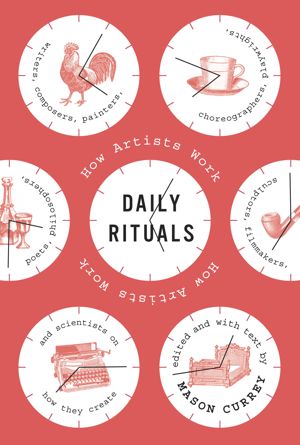
By Tom Peterson
My daily ritual usually includes a little reading from some nonfiction book. The genre wanders: social change, business or marketing, psychology, history, biography, spirituality and so on. I just finished the book Daily Rituals by Mason Currey.
“Nearly every weekday morning for a year and a half,” he says, “I got up at 5:30, brushed my teeth, made a cup of coffee, and sat down to write about how some of the greatest minds of the past four hundred years approached this exact same task—that it, how they made the time of each day to do their best work, how they organized their schedules in order to be creative and productive.”
The result of Currey’s daily ritual is a glimpse at the daily lives of 161 artists, writers, composers, inventors and other creative folks. We learn bits about when they got up, when they ate, when and how they worked.
Substance Use/Abuse
It’s rampant, especially coffee, cigarettes, alcohol. But a surprising number of these creators were into crazier stuff. Hungarian Mathematician Paul Erdős “was a fanatic workaholic,” says Currey, “who routinely put in nineteen-hour days, sleeping only a few hours a night.” Erdős also had an amphetamine habit, “which he supplemented with shots of strong espresso and caffeine tablets. ‘A mathematician,’ he liked to say, ‘is a machine for turning coffee into theorems.’” And how often do conservative Libertarians mention that Ayn Rand wrote The Fountainhead “fueled by Benzedrine pills”?
Work and Sleep Times
All over the place. Plenty of morning people, and plenty of late night folks. As a child, Isaac Asimov would open his father’s candy store in Brooklyn at six in the morning. “I have kept the candy-store hours all my life. I wake at five in the morning. I get to work as early as I can. I do this every day in the week, including holidays. I don’t take vacations voluntarily, and I try to do my work even when I am on vacation.”
And some experiment: For many years, Buckminster Fuller would take a 30 minute nap after each six hours of work. And work habits can change over time. Says Currey, “For her first novel, Interview with a Vampire, [Ann] Rice wrote all night and slept during the day.” Hmmm. But when she had her first child, Rice switched to writing in the day.
Walking. It’s remarkable how many of them would break up their day with a long walk. Darwin took three. Getting away from the work space, outdoors, rumination time.
A couple of snippets from Daily Rituals:
Ingmar Bergman: “Do you know what moviemaking is? Eight hours of hard work each day to get three minutes of film. And during those eight hours there are maybe only ten or twelve minutes, if you’re lucky, of real creation.”
Gertrude Stein said she wrote only 30 minutes each day, “If you write a half hour a day it makes a lot of writing year by year.”
In the end, routine is almost always the foundation for getting stuff done. What these folks have in common was a daily ritual. And it was a rare bird who waited around for inspiration. They got out of bed at some time (or several times) and got around to their creation—on a regular basis.
Update: You can see others as they are added at Mason Currey’s blog, Daily Routines.
See also the Power of Repetition.

No comments yet.